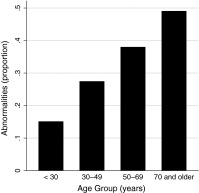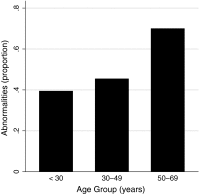Prevalence of triangular fibrocartilage complex abnormalities regardless of symptoms rise with age: systematic review and pooled analysis
- PMID: 25091224
- PMCID: PMC4397769
- DOI: 10.1007/s11999-014-3825-1
Prevalence of triangular fibrocartilage complex abnormalities regardless of symptoms rise with age: systematic review and pooled analysis
Abstract
Background: Triangular fibrocartilage complex abnormalities seem to be more common with age, but the degree to which this is so, and the degree to which the presence of an abnormality is associated with symptoms, are topics of controversy.
Questions/purposes: We wished to perform a systematic review to determine the prevalence of triangular fibrocartilage complex abnormalities, and to determine if the prevalence of abnormalities are greater with increasing age. In addition, we stratified age groups based on symptoms.
Methods: We searched MEDLINE, EMBASE, and the Cochrane Library through August 15, 2013. Studies that reported triangular fibrocartilage complex abnormalities by age were included. Fifteen studies including 977 wrists met our criteria and reported a total of 368 (38%) triangular fibrocartilage complex abnormalities. Eight studies included symptomatic patients; the remainder studied cadavers (six studies) or asymptomatic volunteers (one study). Patients were divided into four age groups (< 30, 30-49, 50-69, and 70 years and older) for pooled analysis, comparing the proportions of patients with and without abnormalities between groups using chi-square analysis. We also evaluated the proportions after stratifying each age group by symptoms.
Results: Overall, the prevalence of triangular fibrocartilage complex abnormalities increased with age, from 27% (80/301) in patients younger than 30 years to 49% (130/265) in patients 70 years and older (p < 0.001), odds ratio (OR), 2.7, 95% CI, 1.9-3.8 (p < 0.001). In asymptomatic patients, triangular fibrocartilage complex prevalence abnormality increased from 15% (24/159) to 49% (129/263) in the same age groups (p < 0.001), OR, 5.4, 95% CI, 3.3-8.9 (p < 0.001). For symptomatic patients prevalence ranged from 39% (56/142) to 70% (14/20) in patients between 50 and 69 years old (p < 0.034), OR, 3.6, 95% CI, 1.3-9.9 (p < 0.014).
Conclusion: Triangular fibrocartilage complex abnormalities are common in symptomatic and asymptomatic wrists, and they are increasingly common with age. As in all situations where abnormalities are so common that they may be incidental, we need (1) a reliable and accurate method for determining whether these abnormalities are the cause of symptoms; and (2) evidence that treatment of these abnormalities improves symptoms better than placebo.
Level of evidence: Level III, prognostic study. See the Instructions for Authors for a complete description of levels of evidence.
Figures




Comment in
-
CORR Insights: Prevalence of triangular fibrocartilage complex abnormalities regardless of symptoms rise with age: systematic review and pooled analysis.Clin Orthop Relat Res. 2014 Dec;472(12):3995-6. doi: 10.1007/s11999-014-3890-5. Epub 2014 Aug 27. Clin Orthop Relat Res. 2014. PMID: 25160941 Free PMC article. No abstract available.
References
-
- Blair WF, Berger RA, el-Khoury GY. Arthrotomography of the wrist: an experimental and preliminary clinical study. J Hand Surg Am. 1985;10:350–359. - PubMed
-
- Bottke CA, Louis DS, Braunstein EM. Diagnosis and treatment of obscure ulnar-sided wrist pain. Orthopedics. 1989;12:1075–1079. - PubMed
-
- Brown JA, Janzen DL, Adler BD, Stothers K, Favero KJ, Gropper PT, Connell DG. Arthrography of the contralateral, asymptomatic wrist in patients with unilateral wrist pain. Can Assoc Radiol J. 1994;45:292–296. - PubMed
Publication types
MeSH terms
LinkOut - more resources
Full Text Sources
Other Literature Sources
Medical
Research Materials
Miscellaneous

